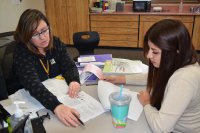Getting Students to Engage With Feedback
Scaffolding feedback can be an effective way to help students improve their work.
Your content has been saved!
Go to My Saved Content.At the core, feedback is an assessment with recommendations to strengthen an assignment or project. Ideally, such recommendations should be provided along the way, prior to assignment submission. But feedback is not merely a series of recommendations, but a reflection of teacher planning and student engagement. For teachers, what does feedback planning look like? For students, what does engagement with feedback involve? Plan for feedback in a way that encourages student engagement.
Show Students Why Feedback Matters
Take the time to directly show students how feedback impacts performance. Professor Norman Eng writes about the idea of showing versus telling to address student misconceptions. For the purpose of demystifying the feedback concept, it is helpful to explicitly show students. I discuss the link between the use of feedback and the score earned. For instance, my class examines two hypothetical examples of student scores from a previous course; we compare one with incorporated feedback and one without the use of feedback. Students are able to see how incorporating feedback can improve their score.
Share outcomes based on previous student responses toward the feedback process. For example, I may discuss impressive student participation trends such as the number of feedback tasks submitted early or the number of individual student feedback exchanges that went beyond what was required. Also, I provide classroom examples for when a student was more receptive to feedback, demonstrated by initiating questions or developing a more detailed response to feedback journal prompts, as well as when a student seemed more defensive, demonstrated by disagreeing with comments or submitting feedback tasks after the deadline.
Explain how the feedback process helps students hone essential skills. I share a student quote from a previous feedback exchange to demonstrate the need for adaptability: “There were small things I missed that I could easily change to get more points.” Another student quote highlights the need for conscientiousness: “I didn’t look at the outline thoroughly… I should have paid more attention.”
Explain Feedback Expectations
Make a connection between the expectations of an assignment and feedback. When I set an expectation, I explain how I will give feedback and the way students should apply the feedback to their work. For example, I tell students how I will deliver the feedback: face-to-face and email, or handwritten. I also explain what support I will offer to help students respond to the feedback. For example, when students are working with peers, I provide fill-in-the-blank stems such as “Based on the teacher’s feedback, we would rate the student’s performance as ___ because___.” When students are working independently, I provide a feedback journal prompt such as “Identify one teacher comment and explain one reaction to the comment.”
On a long-term project, we create a completion timeline checklist that includes feedback and response. We discuss the stages of the project and when students will create feedback journal entries and feedback action steps with peers. We also examine what feedback-related tasks will be addressed during class sessions and what will be completed as homework. I describe what students can expect from me in terms of how long it typically takes for students to receive feedback and how often I will offer feedback.
Also, I consider the use of feedback when developing the rubric. Include details of what would help a student receive high marks for incorporating feedback. For example, if “Task Preparation” is one of the rubric criteria, a student who would receive the most credit would be one who consistently writes feedback journal entries or documents a variety of action steps with a peer. As a project or assignment progresses, remind students about the initial expectations.
Check for Understanding
Admittedly, my students have submitted assignments and then reported that they did not “get” the feedback. To avoid this, it is helpful to check for understanding of the feedback in advance of assignment submission.
Use checkpoints or specific dates, agreed upon in advance, to assess if students understand the feedback and to identify any muddy areas in need of clarification. During the checkpoints, it is useful to ask students some of the following questions:
- How would you describe the content of the feedback in your own words?
- How does the feedback relate to the assignment guidelines?
- What additional questions come to mind as a result of the feedback?
Provide Opportunities to Interact With Feedback
Create opportunities for students to interact with feedback during class sessions. One opportunity may include students working with peers to explore action steps in response to feedback. Ask students to assess the teacher’s comments with attention to which comments are the most pressing or unexpected. Students can use their analysis of the comments to prioritize how to incorporate feedback.
Students may work with peers to rate their overall performance based on the teacher’s feedback. For example, students may identify which teacher comments suggest that the work is strong and which indicate that the work needs more attention. The exercise helps clarify if the student should continue on the same course or shift gears to make needed adjustments.
Another option is for students to develop a written response to teacher feedback as a quick activity. Ask students to identify one reaction, one area for clarification, or one action step related to the feedback. Adjust classroom assessment routines such as allowing students to use feedback to analyze errors and then attempt to improve their performance by applying the comments/hints that I have provided.
Feedback is an ongoing process. It is an intentional dialogue that may start with the teacher, but it must not end there. Demonstrate how feedback connects with performance, check for student understanding, and offer opportunities for student engagement.
